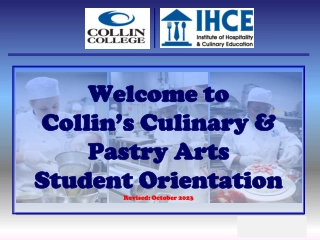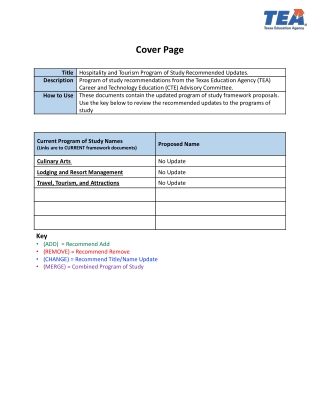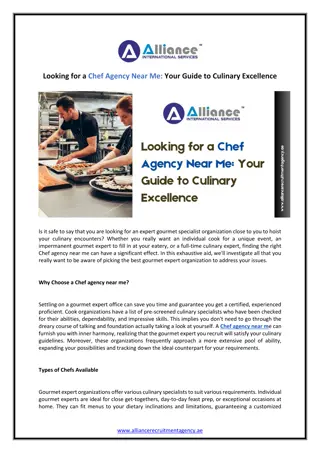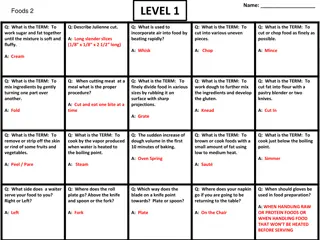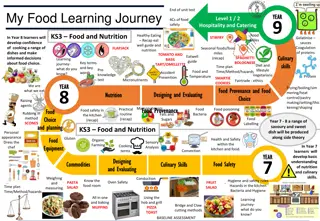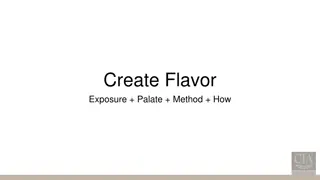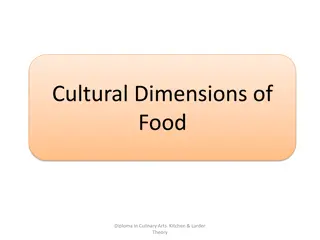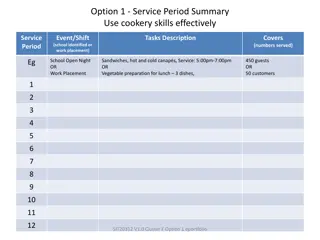Culinary Knowledge at Different Levels
Delve into a comprehensive set of culinary questions ranging from basic food preparation terms and techniques to food safety, measurement conversions, and cooking temperatures. Explore topics such as knife skills, proper table setting etiquette, and essential knowledge for cooking different types of meats and foods. Sharpen your culinary expertise with information on nutrition, kitchen hygiene, appliances, and meal planning.
Download Presentation

Please find below an Image/Link to download the presentation.
The content on the website is provided AS IS for your information and personal use only. It may not be sold, licensed, or shared on other websites without obtaining consent from the author. Download presentation by click this link. If you encounter any issues during the download, it is possible that the publisher has removed the file from their server.
E N D
Presentation Transcript
Name: ___________________ LEVEL 1 Foods 2 Q: What is the TERM: To work sugar and fat together until the mixture is soft and fluffy. Q: Describe Julienne cut. Q: What is used to incorporate air into food by beating rapidly? Q: What is the TERM: To cut into various uneven pieces. Q: What is the TERM: To cut or chop food as finely as possible. Q: What is the TERM: To mix ingredients by gently turning one part over another. Q: When cutting meat at a meal what is the proper procedure? Q: What is the TERM: To finely divide food in various sizes by rubbing it on surface with sharp projections. Q: What is the TERM: To work dough to further mix the ingredients and develop the gluten. Q: What is the TERM: To cut fat into flour with a pastry blender or two knives. Q: What is the TERM: To remove or strip off the skin or rind of some fruits and vegetables. Q: What is the TERM: To cook by the vapor produced when water is heated to the boiling point. Q: The sudden increase of dough volume in the first 10 minutes of baking. Q: What is the TERM: To brown or cook foods with a small amount of fat using low to medium heat. Q: What is the TERM: To cook just below the boiling point. Q: What side does a waiter serve your food to you? Right or Left? Q: Where does the roll plate go? Above the knife and spoon or the fork? Q: Which way does the blade on a knife point towards? Plate or spoon? Q: Where does your napkin go if you are going to be returning to the table? Q: When should gloves be used in food preparation?
Name: ___________________ LEVEL 2 Foods 2 Q: 1/4 cup = ______ Tablespoons? Q: 1/2 cup = ______ Tablespoons? Q: ______ cups = 1 pint? Q: ______ Pints = 1 quart? Q: ______ fluid ounces = 1 quart? Q: It s more accurate to use (choose one) scale/measuring cups when preparing a recipe? Q: What food bourne illness is associated with not washing hands after using the bathroom (feces)? Q: Improperly canned foods can cause this food bourne illness? Q: This food bourne illness comes from fresh poultry and raw eggs: Q: ______ ounces = 1 pound? Q: 1 Tbsp. = ______ tsp. Q: 1 c. = _______ Tbsp. Q: 1 gal. = ______ qt. Q: 1 stick of butter = ________ c. Q: 1/8 c. = ______ Tbsp. Q: 1 c. = ______ fluid oz. Q: 1 qt. = ________ c. Q: 5 1/3 Tbsp. = ______ c. Q: What two cups do you use to measure 3/4 c.? Q: What vegetables make up a mirepoix?
Name: ___________________ LEVEL 3 Foods 2 Q: Where is the best place to insert a meat thermometer? Q: What is the temperature danger zone? Q: What is the correct internal temperature for cooking WHOLE meats, such as seafood, pork, beef veal, or lamb? Q: What temperature should leftovers be reheated to? Q: What is the appropriate temperature for cold storage? Q: Explain FIFO. Q: Where in the refrigerator should meat be stored or thawed? Q: What does clean mean? Q: What does sanitize mean? Q: When creating a work plan, which task would be done first? A. Setting table B. Saut ing chicken C. Steaming veggies D. Boiling pasta Q: This appliance is used for chopping, mixing, or pureeing foods; little to no liquid required. Q: What are the three energy providing nutrients? Q: What are the three non- energy nutrients? Q: After an intense workout, how soon should you start refueling your body? Q: How many foods should be introduced to a child at a time? Q: This appliance is used to blend or puree food in the contain in which it is being prepared. The motor is above the blade. Q: Name 4 courses (or categories) of salads Q: True or False: Exercise is an excellent way to lower fat and cholesterol in the body. Q: How many grams of fiber are recommended daily? Q: What is a beverage that is great for refueling after a work out or athletic event?
Name: ___________________ LEVEL 4 Foods 2 Q: How many calories per gram do proteins provide? Q: Name two foods that could provide protein in a salad. Q: What is the function of liquid in bread? Q: What is the bone disease caused by lack of calcium? Q: What is the disease caused by lack of iron? Q: What kinds of snacks are appropriate throughout the day? Q: If a label says Juice it is 100% juice. T or F Q: Give 2 benefits of convenience foods. Q: Give 3 drawbacks of convenience foods? Q: How are ingredients listed on a nutrition label? Q: What constitutes a main dish salad? Q: How should soup be stored? Q: What ingredient provides structure in yeast breads? Q: What is the function of fat in a pastry? Q: What temperature of water should be used when making pastry? Q: What happens if pastry dough is over handled? Q: What types of pies need to be refrigerated? Q: Give 3 examples of dry cooking methods. Q: Give 2 examples of moist cooking methods. Q: What is it called when yeast bread has time to rise before baking?
Name: ___________________ LEVEL 5 Foods 2 Q: Define Mise en Place Q: Define Al Dente Q: Define Yield Q: The last meal before participating in an intense sporting event should contain mostly __________. Q: Name a food source that provide fats in a salad. Q: This type of dough contains relatively small amounts of fat and sugar. Q: This type of dough has added fat, sugar, and eggs. Q: What food-borne illness is associated with unpasteurized dairy products &/or contaminated water? Q: What is the best way to prevent food-borne illnesses? Q: Which mother sauce is white, is made with milk or cream, and is thickened with a roux? Q: Define fermentation Q: What mother sauce would be used to create marinara sauce? Q: A pie crust that is cooked before filling. Q: What are two classifications of salad dressings. Q: Liquid created by cooking meat, bones, or vegetables. Q: What ingredient does yeast feed on? Q: What kills yeast? Q: What is a roux? Q: What is a roux used for? Q: The best place to thaw meat.
Name: ___________________ LEVEL 6 Foods 2 Q: What temperature should ground meat be cooked to? Q: What is the term for foods that contain high amounts of vitamins, minerals and other nutrients, but few calories? Q: What temperature should poultry be cooked to? Q: A place setting for one on the table is called a ______________? Q: 1/2 cubes are called ___________? Q: 1/4 cubes are called ___________? Q: Adult onset diabetes Q: List one lean cooking method. Q: When buttering a roll what is the proper procedure? Q: What are the Aesthetic Guidelines? Q: A batonnet cut is approximately how big? Q: Name 3 good time-management tips for working in the kitchen. Q: Which mother sauce is brown and is made with stock and veggies? Q: In a salad, what nutrients do fruits and vegetables provide? Q: What is the order for using flatware? Q: List two grocery shopping strategies. Q: What is the ratio of oil to vinegar in a vinaigrette salad dressing? Q: What are the two categories of soups? Q: What cooking method is great for poultry? Q: Less tender cuts of meat should be cooked with what cooking method?


